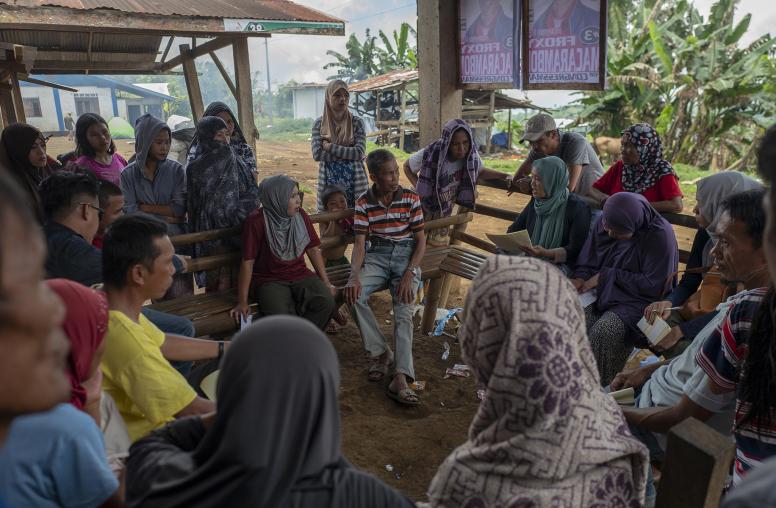In 2019, USIP’s Public Education team launched a pilot partnership with Inspired Classroom to engage students in grades 6-12 across the U.S. in creating projects that elevate peacebuilding stories from around the world to contrast with the stories of violent conflict and extremism that tend to dominate the news cycle.
The USIP & Inspired Classroom Challenge
In 2019, USIP’s Public Education team launched a pilot partnership with Inspired Classroom to engage students in grades 6-12 across the U.S. in creating projects that elevate peacebuilding stories from around the world to contrast with the stories of violent conflict and extremism that tend to dominate the news cycle.
The USIP & Inspired Classroom Challenge kicked off around the International Day of Peace in September 2019 and ran through mid-December, ultimately engaging schools in twelve states. It combined teacher-led classroom activities, live virtual events with USIP experts, and original student research. Based on a “Challenge” scenario and working through an online platform, students researched and designed public awareness campaigns about peacebuilding taking place around the world. Using Inspired Classroom’s online platform based around a problem-solving framework, and collaborating in teams, students worked their way through 10 steps: they explored USIP resources to learn about peace, conflict management and peacebuilding; they were tasked with brainstorming roadblocks to raising awareness of peacebuilding in their communities, and developing and evaluating criteria that would make their ultimate campaigns successful; and lastly they were called upon to pull together a final project describing an awareness campaign that would elevate an example of peacebuilding from around the world.
Participants also had the opportunity to connect directly with USIP experts through a series of Live Event Days. The virtual events were structured to mirror the “Challenge” steps: the September sessions connected classrooms with USIP field staff to explore what peacebuilding looks like in conflict zones; the October sessions featured USIP HQ staff talking about identifying and overcoming problems in their work; and the final Live Event Days in November focused on about connecting students from different classrooms in different states with each other to share their learning to date.
Recognizing Student Achievement
Students who successfully completed the USIP & Inspired Classroom Challenge were recognized with a certificate of completion. Eighteen teams from the following schools submitted successful final projects:
- Bozeman High School, Bozeman, MT
In addition to hosting the first Live Event Day at her school, teacher Amy Wallner-Drake integrated the USIP & Inspired Classroom Challenge into several of her classes. Among her students recognized for their final projects was one team which proposed hosting a “Potluck with a Purpose” to connect the local community with Congolese refugees in order to raise awareness about peacebuilders in the Democratic Republic of the Congo. - Centennial High School, Franklin, TN
The school’s peace club, advised by teacher Cassie Bates, spoke with Terfa Heman, a USIP staff member in Nigeria, as part of the September Live Event Day. Inspired by that session, the peace club decided to focus their project on learning more about peacebuilding in Nigeria and finding a way to share their knowledge with as many of their fellow students as possible. They scripted and recorded an educational video to be played as part of the school’s weekly announcements to the student body. - Eastside High School, Gainesville, FL
Seven teams from Spanish teacher Maria Zelaya’s classes qualified to receive a certificate of completion for their USIP & Inspired Classroom Challenge projects. One of those projects proposed creating an art exhibit featuring murals and posters from young people in Israel and the Palestinian Territories who are working together to bridge divides in their communities. The purpose was to show the community at Eastside the importance of youth peacebuilders. - Greenup County High School, Greenup, KY
Students in teacher Jill Armstrong’s class participated in each of the Live Event Days and researched conflict and peace in several different countries. One team chose to focus on the recent peace agreement between Ethiopia and Eritrea as an example of “seeing bridges being built between previous enemy countries.” To raise awareness in their broader community, the students drafted a news article summarizing the history between the two countries and why the peace agreement matters. - West Central High School, Hartford, SD
One of the teams from teacher Joanne Bohl’s class earned a certificate of completion for their proposal for a website highlighting the work of women’s rights advocates in Afghanistan. The students included a virtual scavenger hunt encouraging visitors to explore their entire site. All four teams from Ms. Bohl’s classes implemented their awareness campaigns, which also involved delivering a newscast for fifth graders, creating an animated video, and constructing a poster board presentation for other students—all designed to help young people see how peace is possible around the world.
Learn more about the September Live Event Day

Forging Connections Between Students and Peacebuilders
While speaking to middle- and high-school students as part of the USIP and Inspired Classroom Challenge, Osama Gharizi, USIP’s senior program advisor for Iraq, said, “Next time you hear anything in the news about Iraq, which will most likely be bad, just remember that there are good stories, there is a sense of normalcy, there are positive things that are happening.”




